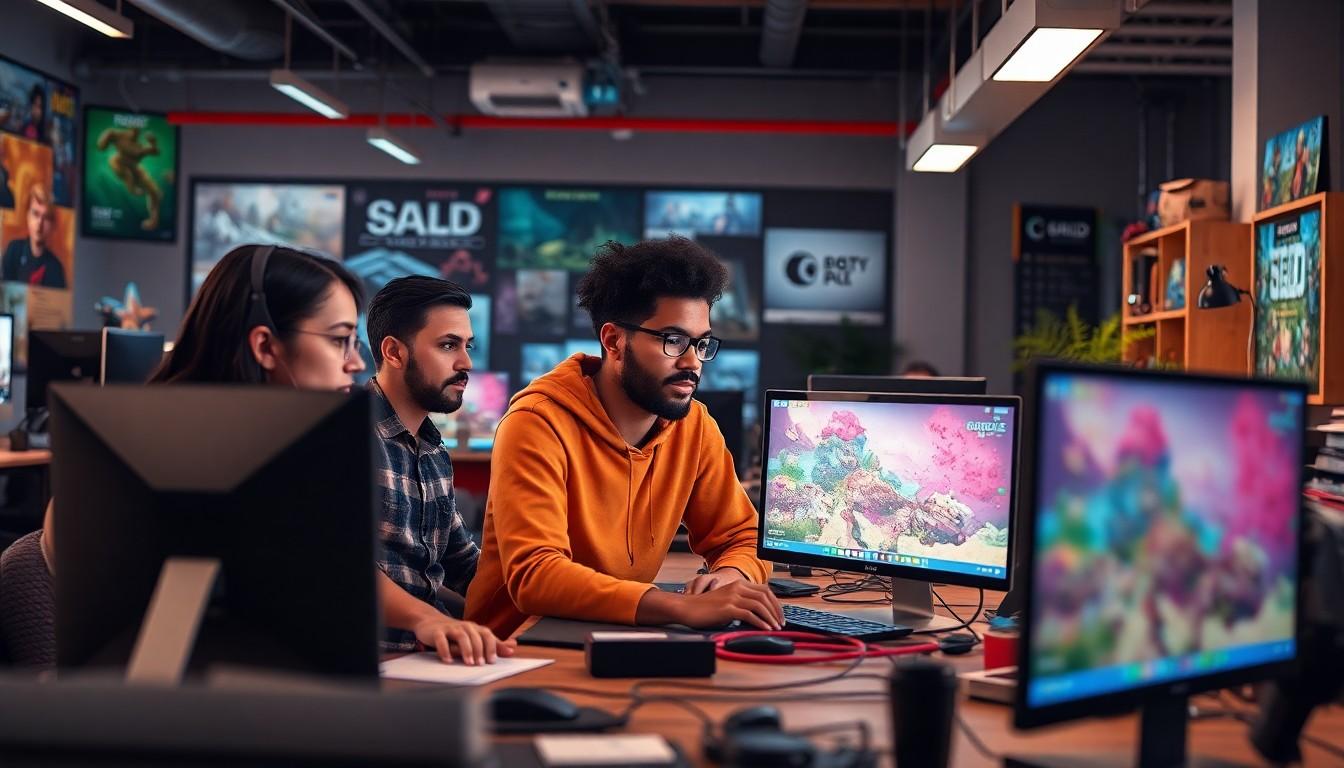In a world where pixels dance and stories come alive, game design and development stand at the heart of it all. It’s not just about slapping some graphics together and calling it a day; it’s a blend of creativity, technology, and a sprinkle of magic. Whether it’s crafting immersive worlds or devising mind-bending puzzles, the art of game creation is as thrilling as the games themselves.
Game Design and Development
Game design and development encompasses several interconnected phases. These phases include concept creation, visual design, programming, and testing. Each stage plays a crucial role in delivering a cohesive and enjoyable product.
Concept creation serves as the foundation of any game. Designers outline game mechanics, target audiences, and overall narratives during this stage. Storytelling involves developing characters and crafting engaging plots that resonate.
Visual design focuses on creating the aesthetic appeal of the game. Artists develop characters, environments, and interfaces to enhance user experience. Well-designed graphics contribute to immersion and engagement for players.
Programming is the heart of game functionality. Developers write code that brings game elements to life, ensuring smooth interactions and technical performance. Utilizing game engines like Unity or Unreal Engine accelerates this process, enabling the implementation of complex systems.
Testing happens continuously throughout development. Quality assurance teams identify bugs, assess gameplay balance, and ensure the overall user experience meets expectations. This iterative process refines gameplay and helps maintain a polished final product.
Marketing and promotional strategies effectively position the game within the industry. Developers create buzz through trailers and demos to attract potential players. Community engagement builds anticipation and encourages user feedback before launch.
The interplay between these elements generates unique and immersive gaming experiences. Successful game design and development demands expertise in creativity, technology, and user experience principles. Each component works together to fulfill players’ desires for interaction, narrative, and challenge in gaming.
Key Components of Game Design
Game design comprises several critical components that work together to create engaging experiences. Each element plays a significant role in ensuring players enjoy their time within the game.
Game Mechanics
Game mechanics dictate player interactions and are fundamental to gameplay. They encompass rules and systems guiding player actions, such as movement, combat, and resource management. Players may experience variations like levels, obstacles, or health points, each enhancing the challenge and excitement. For example, reward mechanisms like points or achievements encourage continued engagement, making the game more addictive. Balancing difficulty ensures a rewarding experience while preventing frustration. Effective mechanics foster creativity and strategic thinking, allowing players to navigate challenges in unique ways.
Storytelling and Narrative
Strong storytelling and narrative create an immersive experience for players. Narratives can vary from simple quests to intricate plots with deep character development. Engaging stories often convey themes, emotions, or moral dilemmas that resonate with players. Compelling characters enable emotional connections, encouraging players to invest in their journeys. Moreover, branching narratives provide choices that influence outcomes, adding replay value. Integration of storytelling with gameplay strengthens the overall experience, as players interact with the world while uncovering its lore.
Visual Design
Visual design forms the aesthetic backbone of a game. It encompasses elements like character models, environments, and user interfaces. Striking visuals can captivate players, establishing the game’s mood and tone. Color schemes, art styles, and animations contribute to the overall experience, guiding player emotions. High-quality graphics provide immersion, while consistent visual themes reinforce the game’s identity. Developers must prioritize functionality alongside creativity, ensuring visual elements enhance rather than distract from gameplay. Together, these aspects create a cohesive and visually stunning experience for players to enjoy.
Game Development Phases
Game development involves distinct phases that guide the project from an initial concept to a fully realized game. Each phase plays a crucial role in creating successful gaming experiences.
Pre-Production
Pre-production forms the foundation for game development. In this phase, teams brainstorm ideas, develop game mechanics, and outline narratives. Designers create concept art to visualize the game’s aesthetic and gather feedback. Establishing a project plan with timelines and milestones also occurs here. This planning ensures teams understand their targets and set realistic budgets. Moreover, identifying the target audience informs decisions regarding gameplay and style.
Production
Production represents the core development phase. It encompasses detailed programming, art creation, and sound design. Developers code the game logic to ensure features function smoothly. Artists design characters, environments, and user interfaces that enhance player immersion. Continuous collaboration among team members during this phase fosters creativity and innovation. Regular iterations and updates keep the project aligned with the initial vision and allow for incorporating feedback from playtesters.
Post-Production
Post-production focuses on polishing the game for public release. Quality assurance teams conduct thorough testing to identify and fix bugs. Feedback from players during beta testing often informs final adjustments and improvements. Marketing strategies also ramp up, generating excitement in the gaming community. Launching promotional campaigns helps build anticipation. Ultimately, this phase ensures the game meets player expectations and delivers an engaging experience.
Tools and Technologies in Game Development
Game development relies heavily on specific tools and technologies that streamline the creation process. Various game engines and programming languages play crucial roles in shaping the final product.
Game Engines
Game engines serve as the foundation for building games, providing essential frameworks and resources. Unity, popular for 2D and 3D game development, offers a user-friendly interface and a vast asset store. Unreal Engine, known for its stunning graphics capabilities, caters to AAA game development with advanced rendering features. CryEngine excels in creating immersive environments with detailed physics and lighting. Both engines support cross-platform deployment, enabling developers to reach broader audiences. Selecting the right game engine often depends on the project’s complexity and the team’s expertise.
Programming Languages
Programming languages are vital for implementing game mechanics and functionalities. C# is widely used in Unity, allowing developers to script interactions efficiently. C++ dominates in Unreal Engine, offering fine control over performance and memory management. JavaScript often integrates with web-based games, enabling dynamic content and interactivity. Python finds its niche in prototyping and tooling, simplifying the development process. Each language has strengths and use cases, guiding developers in choosing the best fit for their projects.
Challenges in Game Design and Development
Balancing creativity and technical limitations presents a primary challenge in game design and development. Designers strive to create compelling narratives and immersive environments while adhering to the constraints of available technology. Competing deadlines often pressure teams, requiring them to manage time efficiently without sacrificing quality or innovation.
Resource allocation consistently impacts the development process. Financial constraints can limit the scope of projects, making it essential for teams to prioritize features that maximize overall impact. Collaboration among diverse team members introduces additional complexities, as developers, artists, and writers must align their visions and workflows to achieve a unified goal.
Player expectations evolve constantly, adding another layer of challenge. Keeping up with trends in gameplay mechanics, storytelling, and visual fidelity demands ongoing research and adaptation. Designers must anticipate how player preferences shift and how these changes influence overall engagement.
Dealing with technical issues arises as a significant hurdle. Bugs and glitches can disrupt gameplay experiences, necessitating rigorous testing and the ability to quickly address problems. Quality assurance teams must work diligently to identify issues across various platforms, ensuring smooth play throughout.
Marketing challenges also play a crucial role in game development. Generating interest in a crowded market requires well-crafted strategies and strong community engagement. Developers need to find effective ways to communicate their game’s unique features to potential players while competing against numerous titles vying for attention.
Ultimately, overcoming these challenges requires a blend of creativity, strategic planning, and teamwork. Effective project management practices further improve alignment among team members, allowing them to navigate obstacles and deliver exceptional gaming experiences.
Future Trends in Game Design
Emerging technologies significantly influence the future of game design. Virtual reality (VR) and augmented reality (AR) are becoming essential for creating immersive experiences. Increased player engagement stems from more interactive environments and realistic simulations.
Artificial intelligence (AI) is shaping game mechanics and character behaviors. Developers are leveraging AI to create adaptive storylines and responsive gameplay. Enhanced NPC (non-player character) behaviors lead to richer interactions within games.
Cloud gaming is gaining traction due to its accessibility. Players can game on various devices without needing high-end hardware. This trend democratizes access to games, expanding player bases and reach.
Procedural generation continues to redefine content creation. By enabling varied environments and unique quests, this technique reduces development time. Designers benefit from the ability to generate vast worlds with less manual effort.
Esports and competitive gaming are influencing design choices. Developers are focusing on balance and fairness to cater to the competitive community. This emphasis on multiplayer experiences fosters increased social interaction among players.
Inclusive design is becoming a priority for game creators. Accessibility features ensure that games cater to diverse audiences. Designers are implementing customizable controls and adjustable difficulty levels.
Sustainability in gaming development is also gaining attention. Eco-friendly practices, like reducing energy consumption, are being integrated. Companies are beginning to prioritize reducing their carbon footprint in production processes.
These trends indicate a dynamic future for game design, where technology, inclusivity, and sustainability intersect. As the industry evolves, developers continuously adapt to player expectations and technological advancements.
Conclusion
Game design and development is a multifaceted journey that combines creativity and technology. As the industry evolves, staying ahead of trends like VR, AR, and AI is essential for creating captivating experiences. Developers must balance artistic vision with technical constraints while navigating challenges such as resource allocation and player expectations.
The collaborative nature of this field fosters innovation and ensures that games resonate with audiences. By embracing inclusive design and sustainability, the future of game development looks promising. As new tools and technologies emerge, the potential for unique storytelling and gameplay continues to expand, inviting players into ever more immersive worlds.


